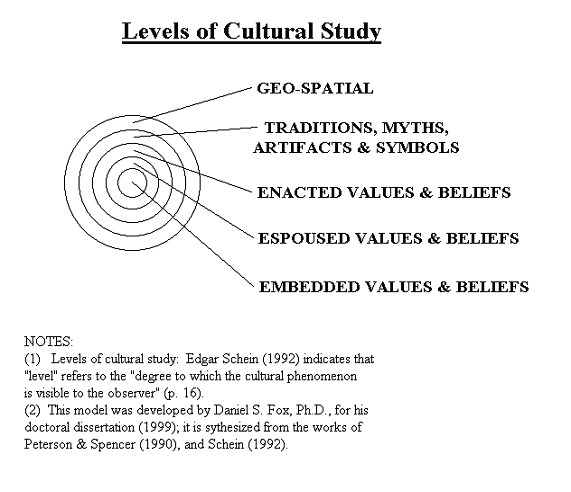|
|
|
|
Directions: The conceptual model (for analysis) is below. Below that are the explanation of terms, a suggested chart for field notes, and an example using a geospatial object on campus at MPC. On the right is the assignment itself. |
||||
 Explanation of Terms Geo-Spatial: (1) tangible and physical elements that express culture. Traditions, myths, artifacts, symbols: (1) rituals, customs, objectics, artistic and religious symbols, factual and non-factual histories; (2) includes what Edgar Schein calls “’Root metaphors’ or integrating symbols: the ideas, feeling, and images groups develop to characterize themselves, that may or may not be appreciated consciously but that become embodied in buildings, office layout, and other material artifacts of the group” (1992, p. 10). Enacted values & beliefs: (1) “observed behavioral regularities when people interact,” such kinesics, proxemics, tactilics; (2) behavioral patterns that extend from a value, value set, belief or beliefs; (3) what people do, practice or nonverbally express. Espoused values & beliefs: (1) “the articulated, publicly announced principles and values that the group claims to be trying to achieve” (Schein, 1992, 9); (2) what people say, orally express, or write about a value, value set, belief or beliefs. Embedded values & beliefs: (1) a more or less integrated set of basic assumptions about the world, including the person’s “sense of what ought to be as distinct from what is;” (2) includes what Schein (1992) calls “Habits of thinking, mental models, and/or linguistic paradigms: the shared cognitive frames that guide the perceptions, thought, and language used by the members of a group and are taught to new members in the early socialization process” (p. 9); (3) includes what Schein (1992) calls “Shared meanings: the emergent understandings that are created by group members as they interact with each other” (p. 9). If held strongly enough in a group, “members will find behavior based on any other premise inconceivable” (Schein, 1992, 19 & 22). References: Fox, D. S. (1999). Orientations of teachers and students toward teacher caring. Doctoral dissertation, Southern Illinois University at Peterson, M. W. & Spencer, M. G. (1990). Understanding academic culture and climate. In W. G. Tierney (Ed.), Assessing academic climate and cultures (pp. 3-18). San Fransisco: Jossey-Bass Publishers. Schein, E. H. (1992). Organizational culture and leadership (2nd ed.).
|
Artifact Safari (created by Dan Fox, Ph.D.) Artifact Safari Course: Intercultural Communication (Speech 4) Professor: Task: · Make a search throughout the campus for artifacts that communicate some aspect of the culture here at · Bring back to the class a description of the artifacts, as well as your interpretation of them in regards to symbols of culture. Be prepared to share your findings with the rest of the class during the assigned period. Artifacts and Culture: · An artifact, in this sense, is a physical object created by people and/or organizations with the intent to symbolically represent an idea, value, or concept. Examples might include logos, news articles, art, advertisements, bulletins, statues, flags, signs, etc. · We are taking culture to be “a learned set of shared interpretations about beliefs, values, and norms, which affect the behaviors of a relatively large group of people” (Lustig & Koester, 1999, 30). · Remember to focus on the ways in which the artifact reflects culture. Directions and Helps: Using the “onion” model of culture (provided in class and located on the website)
i. what the artifact is, ii. where it is located, iii. the details of its appearance and/or location, iv. the symbolic value of the artifact: what was meant by the creators of it, v. what changes or additions to that meaning have occurred (if any), vi. any contradictions evident in it or in connection with other values on campus/in campus culture, and vii. surmised Embedded values, beliefs, attitudes based on what you collected.
|
|||
|
Sample of what Field Notes should include: Cultural elements (based on "onion" model): Emb Esp Ena Trad/Myths Geospat Name: Location: Details: Symbolic Value: Changes and/or Additions: Contradictions: Surmised Emb: Sample analysis notes for MPC flagpole: Name: MPC flagpole Location: See map (provided) Details: See sketch (provided) Symbolic Value: (1) Patriotism: MPC is funded by the state of California (reason tuition is so low); national patriotism expressed by the presence of the flag of the USA; (2) Community value: based on the surrounding lawn space (quite large), the flag pole is set apart as a potential meeting area for the faculty, staff and students of MPC; (3) Important view: for visitor to MPC, the view of the flagpole, backdropped by the varios buildings, and the new library in the distance, it presents an important (impressive?) view; (4) Central point: the flagpole represents a central point to campus (not sure whether it IS, in fact, the central point); it carries the "rally around the flagpole" metaphor. Changes and/or Additions: War and terrorism. The half-mast position of the flag indicates, at different times, the status of the war in Iraq, and to a lesser degree, the war on terrorism. A half-mast position indicates respect and reverence for lives lost among US citizens. In some ways it substitutes for the multicolored the national alertness indicator promoted by the Dept. of Homeland Security. Contradictions: Institutional, but not very personal or communal in value (at least not expressed). The institutional value is more obvious (see above), but the personal value is less evident, and appears vacant. People are not seen giving personal respect to the flag itself. No one gathers at the flag to pray for loved ones, or mourn the loss of soldiers, or remember the events of Sept. 11, 2001. The flagpole, and its flags, stand there like a one pine tree having survived a massive fire, stripped of it branches, white-washed to fit it, and now is ignored to a great degree by the community which now walks around it barely giving a glance skyward at the waving glory of the stars and stripes. Surmised Emb: Patriotism is obvious. Less obvious is the possibility of national and/or state obligation (i.e., obligation to society, fufilled not because of a heart-felt committment to national freedoms and unity of cause, but because it is merely expected... doesn't every school have a flagpole?) |
|
|||
 Remember that Embedded Values and Beliefs are like iceburgs. Scholars characterize this level of culture as "taken for granted," and "assumed." That is, people merely assume them to be true or accepted by all others in that culture. |
||||